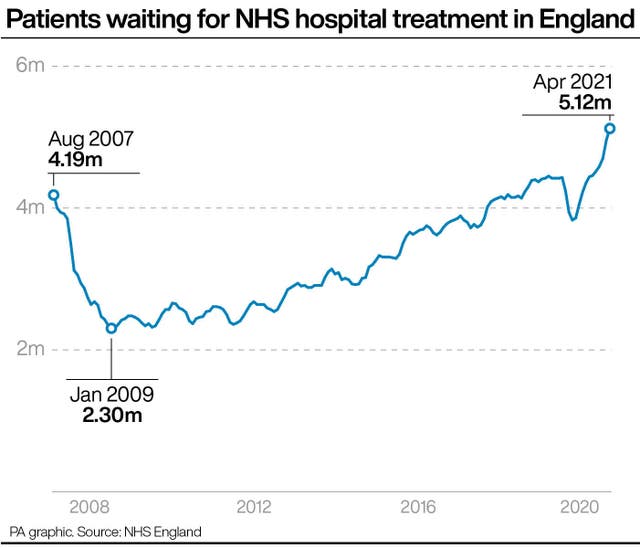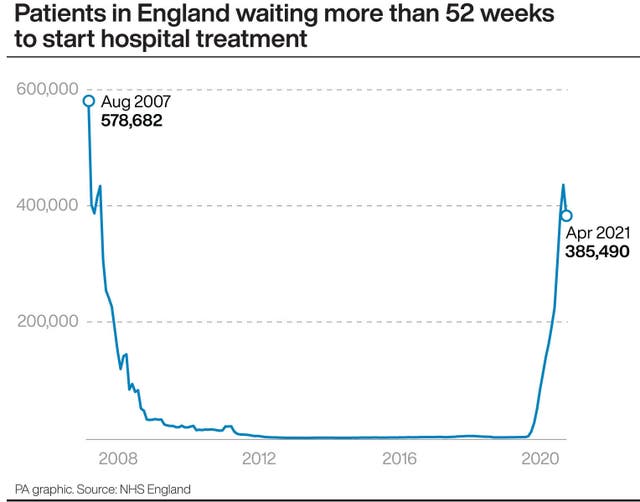England’s NHS waiting list tops 5 million for first time
Figures show 5.12 million people were waiting to start hospital treatment at the end of April – the highest number since records began in August 2007.

The number of people in England waiting to start NHS hospital treatment has risen above five million for the first time, new figures show.
Data from NHS England shows that 5.12 million people were on the waiting list at the end of April – the highest number since records began in August 2007.
The figures, published on Thursday, also show that the number of people having waited more than a year to start hospital treatment stood at 385,490 in April.

This is down from 436,127 in the previous month, but around 35 times the number waiting a year earlier, in April 2020, which was 11,042.
Deborah Ward, senior analyst at The King’s Fund, said nearly 3,000 patients had been waiting for more than two years to start NHS hospital treatment.
She added: “Two years is too long for any patient to be expected to wait for care.
“For those with more severe conditions, long waits could mean months spent in increasing pain or facing the prospect that treatment will be less effective.
“There’s no quick fix, as the NHS tries to tackle the backlog, manage new patients and cope with staff shortages and an exhausted workforce.
“The Government needs to be honest with patients about the time it will take to bring waiting lists under control, and look at a long-term plan for how to give the NHS the resources it needs to sustainably bring down the backlog and provide support for people who will be waiting longer for care.”
Meanwhile, A&E attendances in England last month were 65% higher than a year ago, NHS England said – although this is a reflection of lower-than-usual numbers for May 2020, which were affected by the Covid-19 pandemic.
A total of 2.08 million attendances were recorded in May, up from 1.26 million in May 2020.
The equivalent figure for May 2019, a non-pandemic year, was 2.17 million.
Dr Nick Scriven, past president of the Society for Acute Medicine, said: “The warning signs about where the NHS was heading were glaringly visible a number of years ago and what we are seeing in recent monthly data is the result of a lack of preparedness for the inevitable.
“With acute and emergency care under increasing strain and bed occupancy well over safe levels at more than 90% – yet far less impact from Covid at this point – we have major problems.
“We are in a dire state when it comes to record numbers of people waiting for treatment, but we must also remember the four-hour emergency access target has not been met for years now with little to no change in approach.”
The data also shows the number of people admitted for routine treatment in hospitals in England in April was 223,780 – more than five times the number a year earlier at 41,121, although again this reflects lower-than-usual figures for April 2020 during the first wave of the pandemic.
The equivalent figure for April 2019, a non-pandemic year, was 280,209.
Emergency admissions to A&E departments in England also showed a rise last month, up from 398,406 in May 2020 to 543,754.
The equivalent figure for May 2019, a non-pandemic year, was 547,382.
The NHS England figures also show that a total of 209,452 urgent cancer referrals were made by GPs in England in April, more than double the number in April 2020, which was 80,031.
The equivalent figure for April 2019 was 199,217.
Urgent referrals where breast cancer symptoms were present – though not initially suspected – were up from 3,866 in April to 14,259 in April 2021.
NHS England said the data showed that operations and other routine care were “ahead of ambitions”, while mental health services were back at pre-pandemic levels.
Operations and other elective activity had climbed to 90% of pre-pandemic levels, well ahead of the 75% threshold in official guidance, it added.

Its national medical director, Professor Stephen Powis, said: “Despite the extensive disruption to care caused by the pandemic, it’s encouraging that today’s figures show routine operations, cancer and mental health care have now all rebounded sharply.
“Average waits for non-urgent care have fallen to 11 weeks, and the number of people waiting over 52 weeks fell by more than 50,000 in April.
“Mental health services are back at pre-pandemic levels, and treatment rates for cancer are also now back to usual levels, with nearly 19 out of 20 people starting treatment for the disease within one month.”





